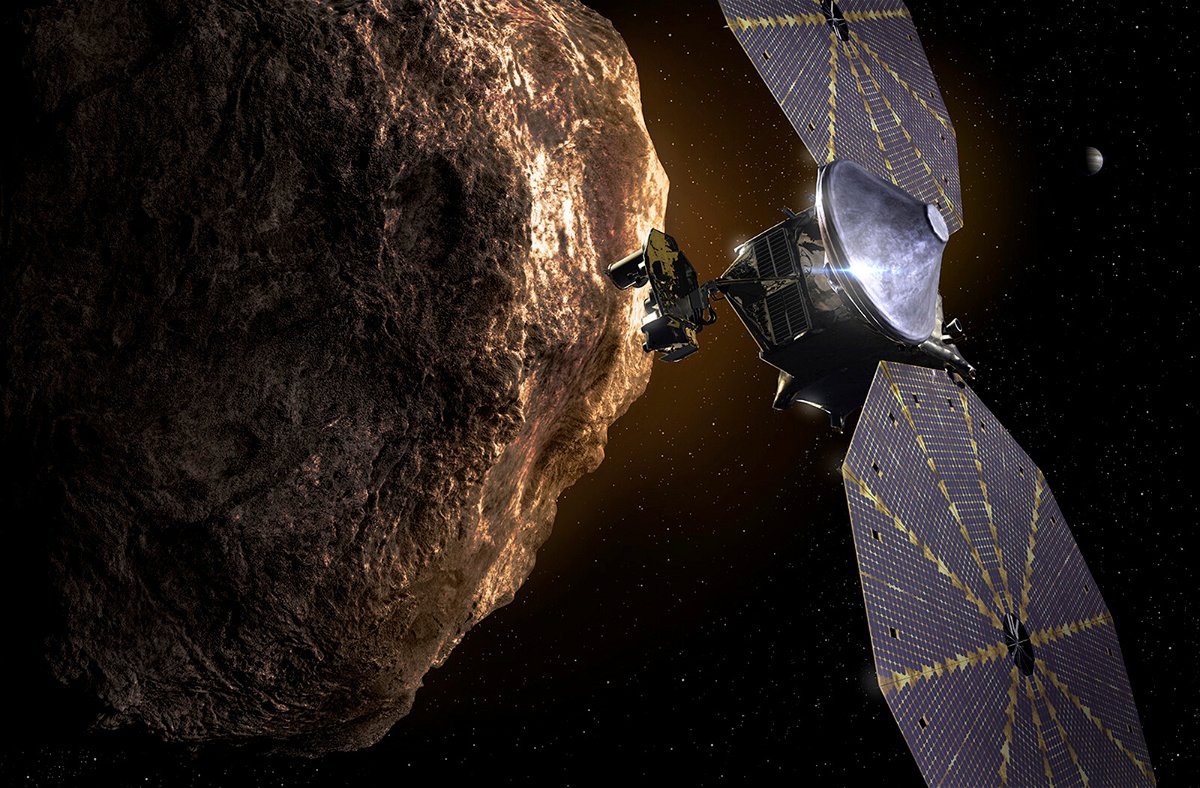NASA’s Lucy mission will observe the earliest ‘fossils’ of the solar system

This illustration shows the Lucy spacecraft passing one of the Trojan asteroids near Jupiter.
By Ashley Strickland, CNN
The first NASA mission to study Jupiter’s Trojan asteroid swarms is getting ready to launch.
The Lucy mission has passed all of its prelaunch tests and is set to leave Cape Canaveral Space Force Station at around 5:30 a.m. ET on October 16.
The Trojan asteroids, which borrow their name from Greek mythology, orbit the sun in two swarms — one that’s ahead of Jupiter, the largest planet in our solar system, and a second one that lags behind it.
Lucy is the first spacecraft designed to visit and observe these asteroids, which are remnants from the early days of our solar system. The mission will help researchers effectively peer back in time to learn how the solar system formed 4.5 billion years ago.
Lucy’s 12-year mission could also help scientists learn how our planets ended up in their current spots.
There are about 7,000 Trojan asteroids, and the largest is 160 miles (250 kilometers) across. The asteroids represent the leftover material still hanging around after the giant planets in our solar system, including Jupiter, Saturn, Uranus and Neptune, formed. Even though they share an orbit with Jupiter, the asteroids are still very distant from the planet itself — almost as far away as Jupiter is from the sun, according to NASA.
“With Lucy, we’re going to eight never-before-seen asteroids in 12 years with a single spacecraft,” said Tom Statler, Lucy project scientist at NASA Headquarters, in a statement. “This is a fantastic opportunity for discovery as we probe into our solar system’s distant past.”
The spacecraft is set to fly by an asteroid in the main asteroid belt between Mars and Jupiter, and then it will explore seven of the Trojans. Over the course of its mission, Lucy will end up swinging back to Earth’s orbit three separate times for gravity assists that can slingshot it on the right path. That will make Lucy the first spacecraft to travel to Jupiter and return to Earth.
“Launching a spacecraft is almost like sending a child off to college — you’ve done what you can for them to get them ready for that next big step on their own,” said Hal Levison, the principal investigator of the Lucy mission, based at the Southwest Research Institute in Boulder, Colorado, in a statement.
The mission borrows its name from the Lucy fossil, the remains of an ancient human ancestor discovered in Ethiopia in 1974. The skeleton has helped researchers piece together aspects of human evolution, and the NASA Lucy team members hope their mission will achieve a similar feat regarding the history of our solar system.
“We view these objects as being the fossils of planet formation,” Levison said.
Both the fossil and the mission are a nod to the Beatles tune, “Lucy in the Sky with Diamonds,” which is why the logo for the Lucy mission includes a diamond.
The Lucy spacecraft is more than 46 feet (14 meters) from tip to tip, largely due to its giant solar panels — each about the width of a school bus — designed to keep up a power supply to the spacecraft’s instruments. But Lucy also has fuel to help it execute some skilled maneuvers on the way to the asteroids.
Over 12 years, Lucy will travel nearly 4 billion miles (6,437,376,000 kilometers) moving at about 400,000 miles per hour (17,881.6 meters per second).
Lucy will specifically visit these asteroids, all named for heroes you might recognize from Homer’s “The Illiad”: Eurybates, Queta, Polymele, Leucus, Orus, Patroclus and Menoetius.
Though it’s not one of the Trojans, Eurybates was chosen because it’s the largest remnant of an ancient massive collision, meaning that it could reveal a look at what’s inside an asteroid. Observations made using the Hubble Space Telescope revealed that the small asteroid named Queta is a satellite of Eurybates.
Each of the asteroids Lucy will fly by differ in size and color.
“Amazingly, many of these mysterious worlds have been altered very little in the 4.6 billion years since they first formed,” said Lori Glaze, director of NASA’s Planetary Science Division at NASA Headquarters.“The relatively pristine state makes comets, asteroids and some meteorites wonderful storytellers that have preserved clues they can share with us about conditions in the early solar system.”
Lucy will use three science instruments to study the asteroids, including color and black-and-white cameras, a thermometer, and an infrared imaging spectrometer to determine the composition of the asteroids’ surface materials. The spacecraft will communicate with Earth using its antenna, which also can be used to help determine the masses of the asteroids.
Once the Lucy mission has finished, the spacecraft will remain in a stable orbit that retraces the path of its exploration between Earth and Jupiter, and it won’t have a chance of colliding with either for over 100,000 years. Eventually, if the orbit does grow unstable, it will likely head on a doomed mission to the sun or get kicked out of our solar system.
The-CNN-Wire
™ & © 2021 Cable News Network, Inc., a WarnerMedia Company. All rights reserved.